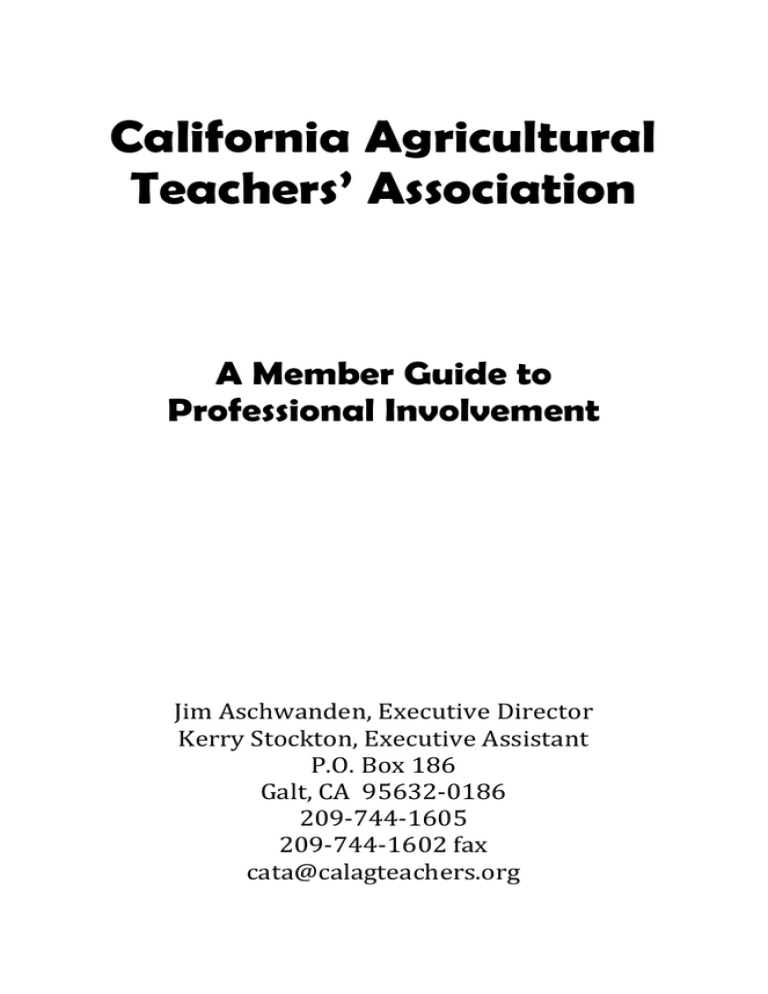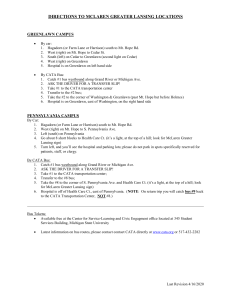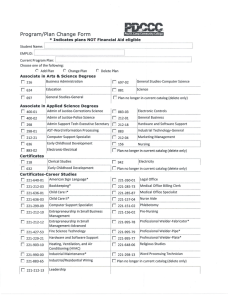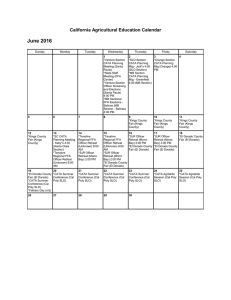California Agricultural Teachers` Association
advertisement

California Agricultural Teachers’ Association A Member Guide to Professional Involvement Jim Aschwanden, Executive Director Kerry Stockton, Executive Assistant P.O. Box 186 Galt, CA 95632-0186 209-744-1605 209-744-1602 fax cata@calagteachers.org California Agricultural Teachers’ Association A Brief History California Agricultural Teachers’ Association (CATA) was formed in 1920. The purpose of the organization is to promote and improve the teaching of agriculture in California and to foster the welfare of those engaged in this work. The implementation of the Smith-Hughes Act in 1917 provided for vocational agriculture to be taught in all public-secondary schools in the United States. In California, J.B. Lillard filled the first position of supervisor for the State Department of Education. At the summer session of agriculture teachers held at the University Farm, Davis, the teachers developed the organizational structure of CATA and elected officers to serve the organization. Charles Booth from Chaffey High School served as the first state CATA president, while R.E. Burton from Santa Cruz High School served as vice-president and R.J. Werner, Esparto High School, served as secretary/treasurer. With the dramatic increase in programs statewide, the State Department of Education divided the state into regions to facilitate and coordinate instructional improvement activities and added regional supervisor positions to assist with development of local programs . In the early 1920s, agricultural education faced many challenges from administrators and others. In an attempt to meet these challenges sectional, regional, and statewide meetings were held on a regular basis so that teachers could share ideas for teaching techniques and for improving curriculum in agricultural education. This peer support and cooperation has been a trademark of agricultural education and has continued to serve as a strength of the CATA organization. In 1928, the California Association of Future Farmers of America was organized. The leadership development of young people involved in agricultural education became an important consideration of CATA. Over the next several years, CATA would develop a series of contests and activities to assist the FFA organization in a leadership development program. A set of rules governing these contests and activities would be developed, which we fondly refer to today as the CATA Curricular Code. Over the next several decades, there was continued growth and expansion of agricultural education throughout California. The junior/community college agricultural programs had a slow start, but began to develop rapidly in the 1960s. Leadership by agricultural instructors at the junior college level has contributed tremendously to the success of the total educational effort in agricultural education. The close communication and cooperation between high school and community college programs has benefited thousands of students enrolled in agriculture. Throughout its history, CATA has maintained a strong tradition of leadership and involvement in other state and national organizations. CATA members have dramatically influenced the structure, policies, and practices of organizations like Association for Career & Technical Education (ACTE) and the National Association of Agricultural Educators (NAAE). Several CATA officers have served on national committees and boards of related organizations, contributing to the overall success of agricultural education. In the early 1980s, CATA members recognized the need to improve their voice in state and national policies affecting agricultural education. Members voted to increase the level of dues paid to the organization, create the position of executive director, and to establish a state CATA office adjacent to the State Capitol in Sacramento. Over the next several years, CATA had a dramatic influence on several key initiatives, including the formation of the Agricultural Incentive Grant program, which greatly increased funding for secondary agricultural education programs in California. For the past eighty years, CATA has contributed greatly to the success of agricultural education efforts in California and beyond. This success can be attributed to the dedication of purpose, selfsacrifice, and vision shared by those involved in this tremendous profession. California's tradition of agricultural excellence is due in great part to those whose lives have been touched by the members of CATA - a legacy of which we can all be very proud. CATA Organizational Structure California Agricultural Teachers' Association is the professional organization for teachers of agriculture in the secondary schools and community colleges in California. The smallest subdivision of CATA is the section, which is made up of all the agriculture teachers in an identified geographical area, usually consisting of one to four counties in size. Each section has a set of elected officers who plan a full calendar of activities for the year. Programs or activities at the section meetings might include: inservice workshops, spouses night, administrators night, FFA competitive events, joint meetings with extension service and agricultural commissioners personnel, etc. The next unit of organization within CATA is the region. There are six regions in California, each consisting of four to six sections. Each region has a fall and spring meeting, planned and conducted by regional officers. In addition, each region holds two business sessions during the CATA Summer Conference. The fall regional meetings usually have, as their focus, professional development of agricultural teachers. Organizational business may be conducted as necessary, and usually deals with concerns from the sections or follow-up business from Summer Conference. The spring regional meetings are scheduled in February, March, or April, and focus primarily on issues facing the professional organization. Agenda items for this meeting are usually generated from concerns voiced at fall regional meetings or generated by the CATA Governing Board at its mid-winter meeting. The CATA Governing Board is composed of the elected state officers, the state division chairs and chairs-elect, and the six regional presidents. Governing board meetings are held in January as the mid-winter meeting and June in conjunction with the CATA Summer Conference. Governing Board duties and responsibilities are outlined in Article VIII of the CATA Bylaws. To provide for the orderly transaction of business, CATA is organized into three divisions. Secondary teachers meet within the Secondary Division to discuss concerns and deal with business items unique to high school programs. College instructors conduct business unique to college programs within the Post Secondary Division. The entire membership comes together in the Operations Division to deal with issues that affect all instructors, regardless of teaching assignment or location. In order to discuss issues in a smaller forum, each of the above divisions has a set of subcommittees that meet at Summer Conference, and in some cases, at various times throughout the year. Governing Board Executive Committee President President-Elect Secretary Treasurer Past-President Chair-Operations Chair-Secondary Chair-Post Secondary North Coast Region Southern Region Central Region San Joaquin Region Superior Region South Coast Region Operations Chair-Elect Post Secondary Chair-Elect Secondary Chair-Elect Operations Vice-Chair Secondary Vice-Chair Post Secondary Secretary Operations Secretary Budget/Audit Nominations/Ballot Curricular Code Membership Services Ag Issues Professional Ethics Teacher Recruitment Tech Prep/Articulation Secondary Secretary Affairs/Relations Inservice Curriculum Student Activities Affairs/Relations Inservice Curriculum Student Activities Operations Division Committees Nominations, Bylaws, and Professional Awards The mission of this committee is to review the qualifications of candidates running for state CATA office, discuss, and recommend proposed changes to the CATA Bylaws, and review the criteria and qualifications for professional awards within the CATA organization. Budget and Audit The committee reviews the proposed annual budget, makes appropriate changes as needed, and sends recommendations regarding the annual budget to the Operations Division meeting. Membership Services The mission of this committee is to formulate, evaluate, and recommend to the CATA membership, through the Operations Division, policies involving: classes of membership, dues and conference fees, recruitment of members, educational exhibits/farm and idea show, Golden Slate, and other services to benefit CATA members and their agricultural programs. Curricular Code This group of committees is charged with updating and correcting the Curricular Code, which governs all FFA contests. One-third of the contests are reviewed annually by the membership, with provisions to open other contests as needed. The proposed changes are discussed in committee, posted for member review, and voted on at the Operations Division meeting. Ag Issues This committee deals with concerns facing the agricultural education profession, including issues involving fairs and expositions and other youth activities. Professional Ethics The goal of the Professional Ethics Committee is to: establish and evaluate the CATA organization's Code of Ethics, mediate and arbitrate unethical situations, and to educate new and continuing CATA members regarding ethical practices within our profession. Teacher Recruitment The mission of this committee is to formulate and recommend strategies to recruit prospective agricultural teachers into our profession. Tech Prep/Curriculum/Articulation This committee's mission is to provide information on parallel and independent curriculum projects for junior high, high school, and community colleges. It also provides communication and education regarding Tech Prep developments and provides a mechanism to assist and guide instructors and schools regarding articulation procedures. Secondary & Post Secondary Division Committees Student Activities This committee deals with issues regarding student leadership activities in their respective division. Student conferences, training, and other matters regarding the overall management of student organizations are referred to this committee. Curriculum This committee deals with all curriculum revision and adoption issues in the division. Special curriculum project funding issues are referred to this committee for recommendation to the full division. Inservice The purpose of this committee is to provide input regarding the development and delivery of statewide inservice activities. In addition, the committee reviews previous inservice activities and critiques the effectiveness of the inservice delivery. Affairs and Relations This committee deals with organization business issues specific to the division. Topics might include: agricultural education legislation, program standards, relations with national professional organizations, and other issues not specifically assigned to other division committees. Involvement and Leadership How to become involved in the California Agricultural Teachers’ Association Become an active member by paying your association dues at the annual conference. Attend sectional and regional meetings, inservices, and professional workshops. How to become an officer in CATA This starts at the sectional level; even first year teachers can be elected into these offices. Officers rotate up through the chairs to provide consistency within the officer teams. In order to run for state office, an agriculture teacher must have completed the rotation through the regional officer positions or held a chairmanship at the state level. How to apply for professional awards This involves being nominated by your peers, usually at the sectional level. The region then votes on a regional winner. However, others who meet the award criteria are welcome to apply. The applications for the following awards are found in the Leadership Handbook that the state, division, and regional officers are given, and on the CATA website. Leadership handbooks can also be purchased from the CATA office. CATA Awards: Due February 15th Teacher of Excellence Outstanding Secondary Program* Outstanding Post Secondary Program* Outstanding Teacher* Outstanding Young Teacher* Agriscience Teacher of the Year* *NAAE Awards - state winners’ applications submitted to nationals. Benefits of Membership Representation in Sacramento: CATA Office Executive Director Communication disseminated through sectional, regional, and state structure in conjunction with the State Agricultural Education Unit. Inservice and preservice workshops and professional sessions. Leadership development opportunities. Agriculture Teacher Network - provides for communication, sharing of ideas, support, and as a resource system. Direct link with the Agricultural Education Unit in the State Department of Education and the Community College Chancellor’s Office. Professional recognition and awards. Member magazine and newsletter: Golden Slate is published three times a year with regional, state, and national agricultural education news. Legislative updates, university messages, and a calendar of events is included. CATA Directory - listing of agriculture educators in California. Curricular Code The Curricular Code is a CATA document that outlines the rules for state FFA leadership development activities, i.e., contests. The content of the Curricular Code may be changed by vote of the active membership of CATA at the annual Summer Conference. This is accomplished through the Curricular Code Committee of the operations division. Curricular Code modifications maybe made in the following manner: 1. One-third of the contest areas are opened for revision on a three-year rotation. 2. Even if in rotation, the contest will only be opened if changes are submitted to the CATA office by June 1. 3. The coach of the state champion team for that contest area will serve as chairperson of that contest area at state CATA Conference. 4. All changes submitted to the CATA office by June 1 will be forwarded to the chairperson for further dissemination. Electronically submitted changes will also be posted on the website at www.calagteachers.org. 5. Only submitted changes will be discussed in the contest committee and summer conference. Out of rotation contest areas: A contest area can be requested to be opened out of rotation. The approval or denial will be made by the governing board prior to conference. The request must be made in accordance with items two through five above. For further clarification-please refer to the Curricular Code. Code of Ethics I am proud of my profession. I shall conduct myself with dignity and in a professional manner. I shall endeavor to grow and develop in my profession. I shall work in harmony with school authorities and other teachers of the school. I shall take an active part in school and community life. I shall work for the advancement of Agriculture and promote agricultural education. I shall be patient, honest and fair in my dealings. I shall treat others with dignity and respect. I shall strive to set before my students, by example, the highest standards of citizenship. I shall give of myself that each of my students may be inspired to make his future life more full and productive.




